
A.W.N. Pugin (1812-1852)"A heaven-pointing spire surrounded by clusters of pinnacles, forming a beautiful and instructive emblem of a Christian's brightest hopes"
Today it was my pleasure to return to the Staffordshire town of Cheadle, this time bringing my wife and my camera, and coinciding our visit with a Traditional Latin Mass (held there once a month) for the great feast of Christ the King.
The first thing that strikes you about the parish church of St. Giles in Cheadle is the huge 200-foot spire which dominates the skyline. The church was built in the 184os, and is the crowning jewel in Pugin's life work.
Here is the entrance through the South Porch, where Pugin envisaged the important liturgical role of this part of the Church, especially in Baptism and Marriage (now lost in the new rites). The floor tiles read "We will go into the house of the Lord with gladness".
On entering the Church the most striking feature is the vibrant colour and exquisite decoration across every inch of the interior. This reflects Pugin's talent as both artist and architect, and with such abundant financing from John Talbot, the 16th Earl of Shrewsbury, no expense is spared!
How is this for a Baptismal font? Wonderfully mounted on carvings of crushed serpents, and situated next to the entrance, to symbolise the sacramental effects of Baptism: The cleansing of Original Sin and incorporation into the Body of Christ, the Church.
"An old English parish church, as originally used for the ancient worship, was one of the most beautiful and appropriate buildings that the mind of man could conceive... the apacious nave and aisles for the faithful... the impressive doom or judgement pictured over the great chancel arch; the fretted screen and roodloft, the mystical separation between the sacrifice and the people, with the emblem of redemption carried on high and surrounded with glory; the great altar, rich in hangings, placed far from irreverent gaze, and with the brilliant eastern window terminating this long perspective..."
A.W.N. Pugin
Perhaps one of the things which touches me most about this church is the way it has been painstakingly preserved and cherished, in contrast to some of Pugin's other masterpieces which are close to my heart, which have been wrecked and reordered with disdain for his original designs (namely the Cathedrals of St. Barnabus in Nottingham, and St. Chad's in Birmingham). A simple parish church like this has survived the great catholic revolution!
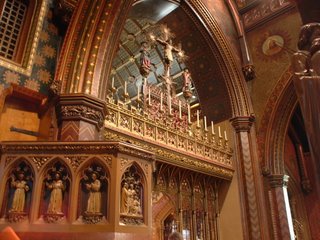
Here, intact, is the beautiful rood screen and beyond it the magnificent high altar, adorned with angels holding musical instruments, and the reredos featuring the Coronation of Our Lady. Also within the sanctuary are features appropriate to the old English 'Sarum' variation of the Roman Rite, in use before the abolishment of Catholicism in the 16th Century. It was Pugin's dream to resurrect this in a true liturgical revival; the Easter Sepulchre, unusual sedilia and sacrarium. Also a separate Blessed Sacrament Chapel, adorned with a whole host of Eucharistic decoration. I am not qualified to comment on any of this, but needless to say, this liturgical revival never happened for Pugin, and the re-established English hierarchy opted to continue saying the codified Roman Rite which the missionaries had used to keep the faith alive during the dark years following the reformation.
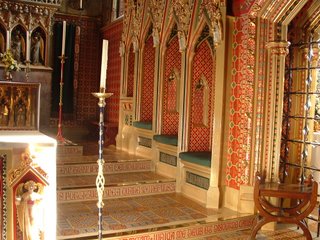
Today it was an honour to see this same mass being celebrated on the high altar. To fit in with the current liturgical 'revolution' there is a small and obtrusive, but beautifully constructed, low altar at the bottom of the altar steps (In many ways the prospect of having mass said versus populum through the rood screen is rather silly!). I have tried to leave this out of my photos, but you will be able to just see it! Notice the wonderful lettering on each of the altar steps, which may mean very little to most modern Catholics, but which to us assembled, bears the timeless words of Introíbo ad altáre Dei, of Psalm 42 which is recited by the priest and servers at the beginning of the Tridentine Mass.

After Mass the priest and servers processed to the Lady Chapel and we sang Salve Regina and a final hymn. We were part of only about 15 people in the congregation, but received a warm welcome with tea and cakes next door afterwards. We thank Alan Frost who is LMS representative for Staffordshire, where they manage to have an Old Rite said every Sunday in alternating locations. We arrived today an hour early, and saw the wonderful attention to detail in preparing the church; including arranging kneelers at the altar steps, decorating the Lady altar with candles, and replacing the tabernacle veil with the white colour appropriate to the feast. They fell short of not being able to remove the low altar altogether!
Whatever you think of Pugin, his work has undoubtedly influenced church architecture hugely in this country. I look forward to learning more about him, but for now I will finish with his thoughts on a parish church like Cheadle's:
It is in fact by parish churches, that the faith of the nation is to be sustained and nourished; in them souls are engrafted to the Church by the waters of baptism; they are the tribunals of penance, and the seats of mercy and forgiveness. In them is the holy Eucharisic sacrifice continually offered up, and the sacred body of our Lord received by the faithful; there the holy books are read, and the people instructed; they become the seat and centre of every pious thought and deed...
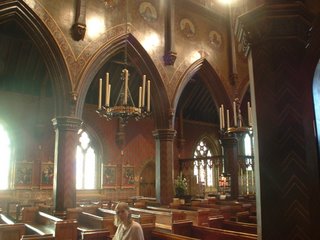







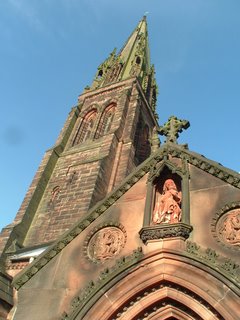
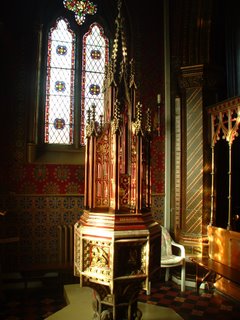
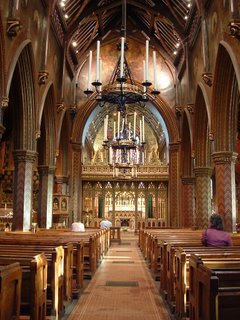

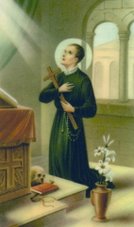








Nice post, Matt. Just been reading about the Mass in Cheadle in 'The Mass of Ages' which arrived this morning. I must try to get to the next one.
ReplyDeleteSince you're in the Birmingham diocese, just wondered if you've ever visited St Mary's in Brewood, Staffs? It's also a Pugin Church - not decorated like Cheadle, but largely untouched by wreckovation. Rood screen went many years ago, but it was a fairly flimsy affair. Small stump altar in place, but High Altar still fully intact and the tabernacle was restored a few years ago. We also have an ancient statue of 'Our Lady of Brewood' on the (untouched) Lady Altar.
That sounds great! Perhaps if the 'universal indult' happens there will soon be use for the high altar again. It is great when high altars are left intact, and will make restoration far easier. I will look up Brewood, but i hope it isn't as far as Cheadle (it took nearly 2 hours to get home on the M6 last night!)
ReplyDeleteBrewood (pronounced (Brood) is just off the A5, a couple of miles west from junction 12 of the M6. We had an Old Rite Mass at the High Altar in 1994 as part of our 150th anniversay celebrations.
ReplyDeleteThank you for these photos of Cheadle. I've wanted to visit it for some time now...
ReplyDelete